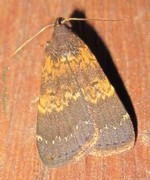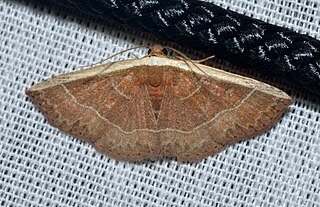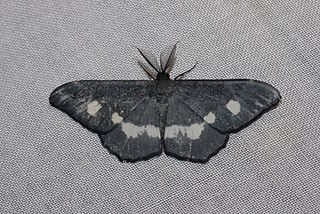
Biston is a genus of large, long-winged moths belonging to the family Geometridae. It is most notable for containing the well-known peppered moth. The genus was first described by William Elford Leach in 1815.

Earias is a genus of moths in the monotypic subfamily Eariadinae of the family Nolidae. The genus was erected by Jacob Hübner in 1825. Species are found throughout Europe, Africa, Asia and Australia, some being agricultural pests such as bollworms.

Ophthalmitis is a genus of geometer moths in the Boarmiini tribe.

Adrapsa is a genus of moths of the family Erebidae. It was erected by Francis Walker in 1859.
Chusaris is a genus of moths of the family Erebidae. It was erected by Francis Walker in 1859.

Dichromia is a genus of moths of the family Erebidae first described by Achille Guenée in 1854.

Hydrillodes is a genus of litter moths of the family Erebidae first described by Achille Guenée in 1854. Its validity is somewhat disputed.

Oruza is a genus of moths of the family Erebidae erected by Francis Walker in 1862.

Agathia is a genus of moths in the family Geometridae described by Achille Guenée in 1858.

Amblychia is a genus of moths in the family Geometridae described by Achille Guenée in 1857.

Chrysocraspeda is a genus of moths in the family Geometridae described by Charles Swinhoe in 1893.

Derambila is a genus of moths in the family Geometridae first described by Francis Walker in 1863.

Cyclophora is a genus of moths in the family Geometridae. Many species are referred to as mochas in reference to their colouration, primarily in Europe.

Hemithea is a genus of moths in the family Geometridae erected by Philogène Auguste Joseph Duponchel in 1829. In 1999 there were about 31 species in the genus.

Hyposidra is a genus of moths in the family Geometridae first described by Achille Guenée in 1857.

Maxates is a genus of moths in the family Geometridae first described by Frederic Moore in 1887.
Nadagara is a genus of moths in the family Geometridae first described by Francis Walker in 1861.

Ozola is a genus of moths in the family Geometridae first described by Francis Walker in 1861.
Pomasia is a genus of moths in the family Geometridae.

Synegia is a genus of moths in the family Geometridae. It was described by Achille Guenée in 1857.

















